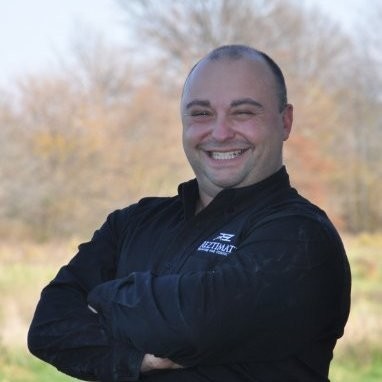5 Questions With Kris Rzesnoski

Kris Rzesnoski, CR, WLS, is the vice president of business development at Encircle. Kris guides the technical development of Encircle’s solutions to ensure they exceed industry expectations. With over 15 of years of experience in the restoration industry, Kris is committed to driving Encircle’s delivery of intuitive, easy-to-use solutions that allow contractors to improve productivity and profitability. Kris sits on RIA’s Restoration Council, Canadian Education Committee and is the chairman of the Estimating Committee.
1. What are the three top trends you see shaping the future of restoration today?
I work with many different groups across the industry, including carriers, TPAs, contractors and IAs, which gives me a unique perspective on trends in the industry. The trends that you see today will continue to reshape the industry over the next few years.
The first trend impacting our industry is proactive adoption of new technology. Adopting new technology is the driving force behind how the restoration industry will work collaboratively and effectively with other industries to achieve common goals. We have to face that our industry is changing for the better. Many of the carrier partners that we work with know that the current model isn’t sustainable and won’t yield the results they want, which is why they’re now adopting new technology. Companies that once feared transparency are now embracing it to create a cohesive relationship between restoration and insurance companies. It’s very similar to the impact that Uber had on the taxi cab industry. We’re not that different. Think of sharing photos, status updates and communicating with stakeholders as the way Uber shows you where they are and how close they are to you. Knowing something is happening and seeing the results does wonders for the user experience.
The second trend you’re already starting to see is the shifting of responsibilities within the industry — independent adjusters and TPA businesses starting to adjust their operations to allow for more specialized experts in the field and less routine assignments. Technology will drive the simplification of tasks back to carriers, and most carriers recognize that deep costs cannot keep coming from the contractor on the actual work in the field. The biggest opportunity for carriers is to heavily reduce the administrative costs associated with handling a claim. Adjusting time, manual systems, third parties, internal legacy systems and even the lengthy review process after a claim is completed all lead to longer cycle times and a heavy administrative burden. Restorers are going back to being more of a partner to carriers like they were 20 years ago.
The third trend that I can see coming is on the technical side of the industry. Restorers are going to have to up their game and get really good at what they do. Most restorers are not looking at their business from the 20,000-foot mark. Twenty years ago, there were less courses to send staff to; the science of restoration wasn’t as complex or studied. The down pressure on pricing has already impacted the technical capabilities of contractors and their ability to invest in the training. Finally, you have the market conditions where staffing is incredibly hard, wages need to be higher to attract dedicated workers to this line of work, and retaining good staff is costly. However, transparency is going to make being a sloppy contractor harder to do, and it will allow the better contractors to succeed. Don’t kid yourself; pricing concerns will always exist. However, the ability to see safety and liability issues that are on the job will move the industry to cleaning itself up.
2. How do you think technology will change the restoration industry in the next five to 10 years?
Honestly, I think that the next five years will be a really exciting time for the industry. The opportunity for restorers to drastically reduce their administration overhead will continue to evolve. This will allow us to improve our operations, reduce our costs and ultimately become very profitable. You’ll have to be savvy with your technology purchases and think of technology not as an expense, but as a productivity investment. You’ll see programs integrating more and more; the industry tech companies have to evolve or they will be replaced by technology that is helping contractors be contractors. The most notable changes you’ll see in the next five years are new players entering the restoration software game from Silicon Valley, the Canadian Technology Triangle (Ontario), and from Australia and UK tech hubs. The external disruption in the industry is a bigger threat for existing companies that have operated without that type of competition for a long time.
3. How does working at a technology-forward Canadian company affect your perspective of the global restoration industry?
Working for Encircle has been an amazing experience. I went from working as a restorator, struggling to find and use technology that actually did what I needed it to do, to working for a company that empowers restorators to improve their operations and reduce costs. I have been able to apply my skills and experience gained as a restorer to directly influence our product development, features and functionality. Additionally, I’ve been able to work in the field with Encircle users around the world (Australia/New Zealand, Canada, USA, UK and other countries) to test products and develop new processes and standards. This has allowed me to see the successes and challenges within the restoration industry from many different perspectives. For me this is really exciting. I get to see the direct impact and benefits of the work that Encircle does.
The global restoration industry faces similar challenges no matter where you go in the world. The commonality I see is that there is a lack of connection between restorers and carriers often resulting in distrust. The toughest system to do business in would be Australia, followed by Canada and then the USA (when looking at TPA/preferred vendor work). In Australia, 90 percent of work is pushed through a vendor program and rules surround billing are incredibly strict. In Canada, 85 percent of works go through vendor programs, and downward pricing pressure has impacted the contractors’ sustainability. If it were not for a few key and large CAT events in 2016, 2017 and 2018, we would have seen high volume, low-margin contractors go bankrupt. The U.S. appears to be trending to increasing vendor programs, but the contractor dynamic here is uniquely entrepreneurial and very protective of running your restoration business your way.
The difference between Canada/AU and the USA is that you also have many more insurance carriers. Compared to Canada and AU, who might have 100 carriers that make up 80 percent of the market, and in some cases multiple carriers are owned by one parent company, the U.S. has many more options, and therefore the opportunity for contractors to work for carriers through their proxies provides more direct relationship opportunities.
Here is the exciting news. The carriers don’t like the way the system is set up either anywhere in the world. They have turned to Encircle to help figure out how to reduce their costs that have skyrocketed. The solutions we are presenting to the industry are definitely catching on. Encircle is working with carriers in Canada, the U.S., UK and AU to streamline processes to allow claim cycle times to be reduced. The restoration and insurance worlds are changing, and they are getting closer together … slowly.
4. What is one piece of professional advice you have for the upcoming generation of restorers?
I would caution restorers that you need to carefully select your technology. Here are some simple thoughts on selecting technology that I wish I had been told.
Think of technology as a productivity tool. For example, you have a choice: Get a free older phone, or get the latest and greatest. Most companies take the free device. These aren’t just calling phones; they are productivity tools in the field and office. A newer phone will run faster, hold more information, and have better cameras and displays. Your staff will engage with them more and do what you need them to do. Not all programs do the same thing. It is like stating that a flip phone and your latest smartphone can do the same thing. They both make calls, they both take pictures and they both can send texts. So why don’t you still use your flip phone? You want the added productivity and improved user experience. Bottom line: Not all technology is the same.
Don’t test unproven technology. Drones, 360 cameras and other technology that is in the adopting stage is great to play with if you have a budget for R&D. But the mainstream investment in your business that will yield the biggest results today are proven technologies. Do you buy your staff two or three monitors? If you add a second monitor, you can increase their productivity by 40-50 percent. If you add a third monitor, you can increase it another 20 percent. A $150 investment can drive engagement in your office. You can only get three screens if you invested in a better computer; do you buy a basic computer or do you get a more powerful computer? Do your staff have the FLIR 1 or the FLIR C3? For under $1,000, your staff can get a FLIR camera to help them with inspections and help justify the proper equipment you need for the job. You need to invest in technology that you’ll get a return of investment from and that will yield you real results.
As a restorer, you need to think about your technology implementations much more strategically than just throwing it at a wall and hoping it sticks. Choose your technology based on your needs, not the needs of others.
5. What is the RIA Restoration Council working on right now that’s most exciting to you?
We’ve got a couple of projects on the go, but I’m most excited about the Estimating Committee, which I am the chairman of. We’re putting together an international body of restoration professionals to review the various pricing models and assumptions from Australia, Canada and the U.S.
The common issue we have seen worldwide is that when pricing is dictated to the contractor, the methodology associated with it is not derived from the services being provided. As restorers, we saw an opportunity to review all the estimating platforms and create a contractors methodology for pricing their services.
In North America, the majority of people use a software program to create their estimates. Do you know what costs are built into the hourly rate or the labor rate? Did you know that project management is not included in the hourly rate of the technicians and should be charged separately?
This applies to all pricing programs and methodologies out there. We want restorers to know how their prices are formed and provide them with a method to compare the pricing methodology with their actual costs to determine which price is right. As a restorer, you need to set the price for your services. In order to do so, you must have a complete understanding of how the price is built in the various systems you are using.
This is a major issue for the restoration industry, as pricing pressures have impacted the industry globally and the various systems of pricing restoration. The committee will be reviewing a number of things impacting estimating including O&P, equipment pricing, T&M, square foot/meter drying, room pricing and other hot topics.
If this is something you’re interested in learning more about, I invite you to reach out and offer your expertise to the committee. We’re still looking for volunteers and would love to talk to you about what we’re doing to help define the future of the restoration industry.
If you’re interested in learning more about Encircle, request a demo to see our solution in action: https://encircleapp.com/request-demo. Anyone can reach me at krzesnoski@encircleapp.com or call me at 204-869-8887.
